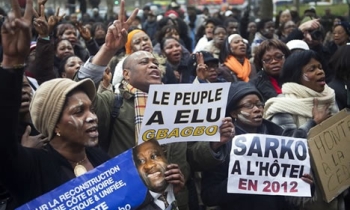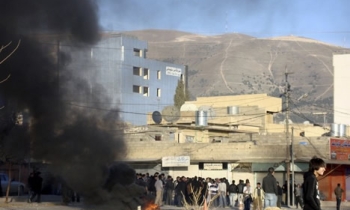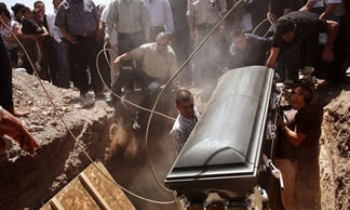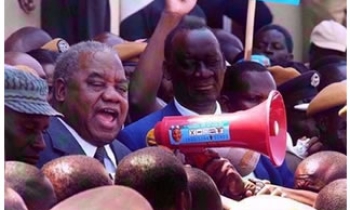Brian Tierney, a onetime critic of the Philadelphia Inquirer who wound up buying the paper, is determined to take his new property in a different direction.
"We don't need a Jerusalem bureau," he says. "What we need are more people in the South Jersey bureau."
But six months after this advertising and public relations executive gained control of a once-proud newspaper that routinely ranked among the country's top 10, he is considering layoffs of as much as 30 percent of an already reduced newsroom staff. That would mean even fewer journalists covering those New Jersey suburbs and just about everywhere else, deepening the sense of gloom at a paper that racked up 18 Pulitzer Prizes between 1975 and 1997.
"The Inquirer, unfortunately, has retreated in all but a couple of symbolic ways from the ambition it had at one time to play in the majors," says veteran reporter Rick Nichols. Tierney's threatened layoffs, he says, "would be carved right out of the heart of local coverage."
Tierney, a fast-talking man who bristles with confidence, casts himself not just as the Inquirer's savior but as the prototype of a new breed of newspaper owner -- a private businessman insulated from the Wall Street profit pressures that plague publicly owned companies. Such pressures ultimately led Knight Ridder to fold this year after selling off the Inquirer and 31 other dailies.
Private ownership is the flavor of the moment. Many staffers at the Los Angeles Times hope that the parent Tribune Co., which fired the paper's editor and publisher after they resisted layoffs, will unload the Times to David Geffen or one of the other California billionaires vying to buy it. A local investment group is also attempting to buy Tribune's Baltimore Sun.
But such ownership has its own pitfalls, which can range from an unfamiliarity with the ethics and ethos of newspapers to shallow pockets that may force even deeper cutbacks. Tierney may be right that local coverage is the Inquirer's core mission, but didn't far-ranging journalism also make the paper attractive for readers?
In its heyday, the Inquirer had 15 foreign and domestic bureaus and a national reputation for tough investigative reporting. But like many big-city dailies, the paper shrank its staff as daily circulation declined, from 470,000 a decade ago to 330,000 today.
"Those of us who've been here a long time have watched the paper being chopped to death, little chunks at a time," says television columnist Gail Shister. "That's hard to watch, because we used to be great. We haven't been great for many, many years."
As a PR man, Tierney often clashed with the Inquirer. When he represented Philadelphia's Catholic archdiocese in 1998, he tried to freeze out a reporter he deemed too critical of the church, likening him to Newt Gingrich writing about Bill Clinton. Inquirer columnist Monica Yant Kinney recalled how Tierney tried to "bully" her in 2002 on behalf of a bank executive.
But when Tierney put together a group of investors to buy the Inquirer and its sister tabloid, the Daily News, from Knight Ridder, he largely overcame the hostile history by signing a pledge not to interfere with the editorial operation. And while he makes financial decisions and sets a broad direction, he has kept his word not to meddle in news coverage. Tierney, who has contributed $200,000 to Republicans over the last decade, according to the Inquirer, also said he would no longer make political donations.
"It was a good business opportunity," Tierney says of the $562 million purchase of the papers. "The best way to protect that investment was not to screw around with editorial integrity."
Tierney boasts that he and his partners are pouring $20 million into the organization this year, from upgrading printing presses to boosting the tiny marketing budget to repainting the lobby. But intensive negotiations with the Newspaper Guild and other unions have both sides preparing for a possible strike, a daunting prospect for those who recall the bitterness surrounding a 45-day walkout in 1985.
Ticking off union work rules that he regards as archaic, Tierney asks: Why should he have to pay overtime to ad salesmen to take a client to a Phillies baseball game? Or to fly to Chicago and take an advertiser to Morton's steakhouse? He also wants to merge certain Inquirer and Daily News departments, saying it's absurd to have a photographer from each paper at the same event or two fleets of trucks delivering the papers.
"I believe I've replaced the selfish, self-centered, short-term focus of Wall Street leadership with the selfish, self-centered, short-term focus of the Guild leadership," Tierney says.
Stu Bykofsky, a Daily News columnist and spokesman for the Guild, calls the accusation "laughable," saying the union hasn't even asked for an employee pay raise. "We're trying to protect our jobs and our pensions," he says, citing Tierney proposals to cap contributions to the pension plan and curtail sick pay. Other work rules are negotiable, says Bykofsky, but Tierney doesn't understand that the Inquirer and Daily News "don't cover news in the same way."
With a combined staff of 525, Tierney says he will lay off between 50 and 150 employees. These days almost all stories inside the Inquirer's A section come from the Associated Press, with a handful from the New York Times, Los Angeles Times or other wire services, and that suits Tierney just fine. The Inquirer, which already lost 85 staffers in the past year through buyouts and attrition, has only three reporters beyond its home base, one in Israel and two in Washington.
"I don't see us sending 25 people to do me-too coverage of Katrina," Tierney says. "I can get what's going on in Iraq online. What I can't get is what's happening in this region."
After Tierney bought the papers in June, he staged a celebration featuring Eagles cheerleaders and catered hoagies. Now he is losing the newsroom's allegiance, and columnists began criticizing the new owner last week in Guild-financed radio ads.
"People are beginning to doubt his veracity," says metro columnist Tom Ferrick Jr., who recorded one ad. "The people who bought the paper may have paid too much for it, and so were less able to withstand what appears to be a large drop in advertising revenue." Tierney dismisses that argument, saying: "We have to have a vision of living with the resources that are there."
Tierney ousted the top editor, Amanda Bennett, three weeks ago and handed her job to William Marimow, a former Inquirer reporter who won two Pulitzers at the paper, in 1977 and 1985. Marimow, most recently National Public Radio's ombudsman, was fired as editor of the Baltimore Sun two years ago after battling Tribune executives over budget cuts.
When Marimow described his plans for beefing up coverage, Kinney told him: "That sounds great, but we can't do those things with the staff we have now." Marimow has said he can revive his hometown paper despite the painful cuts ahead.
Kinney, a 10-year veteran now worried about being laid off, says she "can't even fathom this place with 50 fewer people." It's getting harder to put out the paper, she says, because "everybody's out looking for work."









